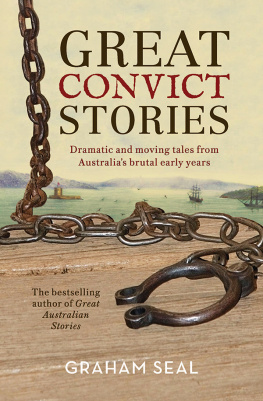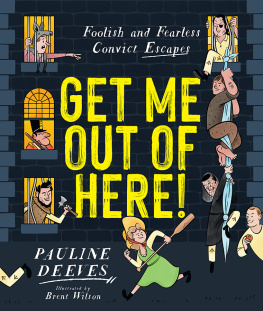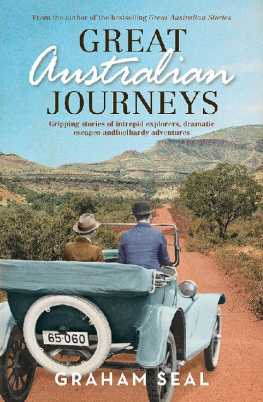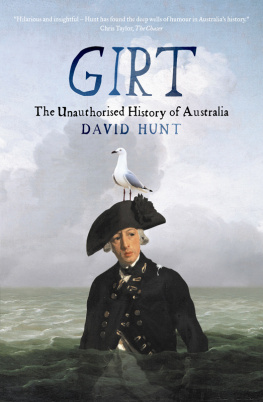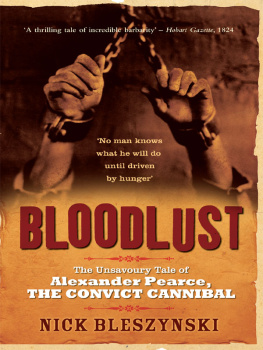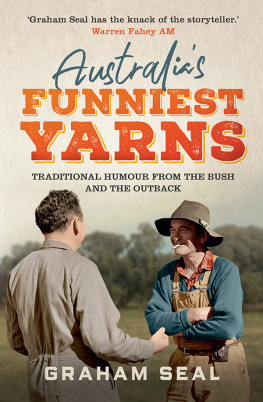
Graham Seal is Professor of Folklore at Curtin University, and a leading expert on Australian cultural history. He is the bestselling author of Great Australian Stories, Great Anzac Stories, Larrikins, Bush Tales and Other Great Australian Stories, The Savage Shore and Great Australian Journeys.
Praise for other books by Graham Seal
Great Australian Stories
The pleasure of this book is in its ability to give a fair dinkum insight into the richness of Australian story telling.Weekly Times
a treasure trove of material from our nations historical pastCourier Mail
This book is a little island of Aussie cultureone to enjoy.Sunshine Coast Sunday
The Savage Shore
A fascinating, entertainingly written, voyage on what have often been rough and murky seas.Daily Telegraph
Colourful stories about the spirit of navigation and exploration, and of courageous and miserable adventures at sea.National Geographic
a gripping account of danger at sea, dramatic shipwrecks, courageous castaways, murder, much missing gold, and terrible loss of life.Queensland Times
Larrikins, Bush Tales and Other Great Australian Stories
another collection of yarns, tall tales, bush legends and colourful charactersfrom one of our master storytellers.Queensland Times
Great Anzac Stories
allows you to feel as if you are there in the trenches with them.Weekly Times
They are pithy short pieces, absolutely ideal for reading when you are pushed for time, but they are stories you will remember for much longer than you would expect.Ballarat Courier
Great Australian Journeys
Readers familiar with Graham Seals work will know he finds and writes ripper, fair-dinkum, true blue Aussie yarns. His books are great reads and do a lot for ensuring cultural stories are not lost. His new book, Great Australian Journeys, is no exception.Weekly Times
An alternative history of outback Australia over the past 200 years.Country Style
Epic tales of exploration, survival, tragedy, romance, mystery, discovery and loss come together in this intriguing collection of some of Australias most dramatic journeys from the 19th and early 20th century.Vacations and Travel

Also by Graham Seal
Great Australian Stories
Great Anzac Stories
Larrikins, Bush Tales and Other Great Australian Stories
The Savage Shore
Great Australian Journeys
First published in 2017
Copyright Graham Seal 2017
All rights reserved. No part of this book may be reproduced or transmitted in any form or by any means, electronic or mechanical, including photocopying, recording or by any information storage and retrieval system, without prior permission in writing from the publisher. The Australian Copyright Act 1968 (the Act) allows a maximum of one chapter or 10 per cent of this book, whichever is the greater, to be photocopied by any educational institution for its educational purposes provided that the educational institution (or body that administers it) has given a remuneration notice to the Copyright Agency (Australia) under the Act.
Allen & Unwin
83 Alexander Street
Crows Nest NSW 2065
Australia
Phone: (61 2) 8425 0100
Email:
Web: www.allenandunwin.com
Cataloguing-in-Publication details are available from the National Library of Australia
www.trove.nla.gov.au
ISBN 978 1 76029 778 7
eISBN 978 1 76063 375 2
Map by Julia Eim
Set by Midland Typesetters, Australia
Cover design: Julia Eim
Cover images: David Moore / Alamy Stock Photo
Contents

I saw a man walk across the yard with the blood that had run from his lacerated flesh squashing out of his shoes at every step he took. A dog was licking the blood off the triangles, and the ants were carrying away great pieces of human flesh that the lash had scattered about the ground. The scourgers foot had worn a deep hole in the ground by the violence with which he whirled himself round on it to strike the quivering and wealed back, out of which stuck the sinews, white, ragged, and swollen.
The infliction was 100 lashes, at about half-minute time, so as to extend the punishment through nearly an hour. The day was hot enough to overcome a man merely standing that length of time in the sun, and this was going on in the full blaze of it. However, they had a pair of scourgers who gave each other spell and spell about, and they were bespattered with blood like a couple of butchers.
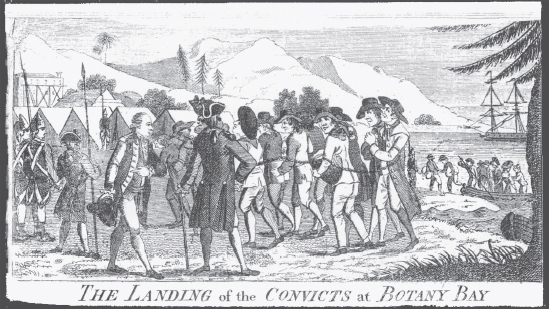
Landing of Convicts at Botany Bay, from Captain Watkin Tenchs A Narrative of the Expedition to Botany Bay, 1789.
More pitiable objects were perhaps never seen. So Surgeon John White described many of the nearly eight hundred convict men and women landed from the First Fleet transport ships after an eight-month voyage from England. About thirty died at sea and many were suffering from scurvy and dysentery. Along with marines, administrators, officials and their families, the convicts had been banished across the sea to found a new penal colony at the far end of the British empire.
Who were these mostly unwilling founders of modern Australia? What compelling stories would they and those who followed them have to tell?
Some were hardened criminals. Some were impoverished tradesmen and workers. A few were political prisoners. The 162,000 or more convicts transported to Australia between 1788 and 1868 were men and women from all walks of life and many different parts of the world. Their crimes were various and while some were harshly or even unjustly treated, by the standards of the time their punishments were mostly expected.
But whatever their sins and their origins, the large number of people who arrived here as transports laid the basis of a new country and have had a continuing influence on the way Australians think about themselves. The convicts established the dislike of authority often associated with our national identity. Their real and imagined doings influenced the larrikin sense of humour we value and often practise. Their existence and the growing opposition to the system also produced the attitude known as the convict stain, a prejudice that for decades obliged many to suppress their convict connections. Australians have only recently begun to confront what was once considered a blot on the national story. The impact of the family history movement, as well as the passing of time, have led to many taking pride in identifying an ancestor who came here in chains. But attitudes change slowly and the convict past still lies uneasily in our history.
Historians have studied and restudied the transported convicts, trying to establish their origins, beliefs and impact on the countrys development. Some have seen them as habitual criminals; others as mostly working people. Some see them as the beginning of an invasion. Little has been agreed and what has been established is subject to change as new generations of researchers examine the penal past from different perspectives. But however the era is interpreted, its many, often contradictory, elements continue to fascinate writers, filmmakers and family historians. Along with Ned Kelly and the Anzac tradition, the history and mythology of convictism is compelling and controversial. Just as the iconic figures of the bushranger and the digger remain with us, so do the images of ragged wretches weighed down in iron chains.
Next page
